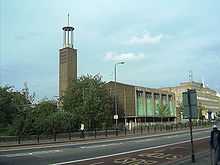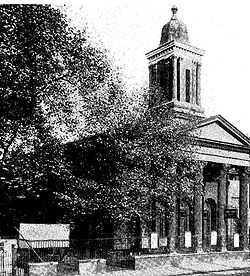Churches in the City of London |
|---|
| | Existing churches |
- All Hallows-by-the-Tower
- All Hallows-on-the-Wall
- City Temple
- Dutch Church, Austin Friars
- St Andrew-by-the-Wardrobe
- St Andrew, Holborn
- St Andrew Undershaft
- St Anne and St Agnes
- St Bartholomew-the-Great
- St Bartholomew-the-Less
- St Benet, Paul's Wharf
- St Botolph, Aldersgate
- St Botolph, Aldgate
- St Botolph-without-Bishopsgate
- St Bride, Fleet Street
- St Clement, Eastcheap
- St Dunstan-in-the-West
- St Edmund, King and Martyr
- St Ethelburga, Bishopsgate
- St Giles, Cripplegate
- St Helen, Bishopsgate
- St James, Garlickhythe
- St Katharine Cree
- St Lawrence Jewry
- St Magnus the Martyr
- St Margaret Lothbury
- St Margaret Pattens
- St Martin, Ludgate
- St Mary Abchurch
- St Mary Aldermary
- St Mary Moorfields
- St Mary Woolnoth
- St Mary-at-Hill
- St Mary-le-Bow
- St Michael, Cornhill
- St Michael, Paternoster Royal
- St Nicholas, Cole Abbey
- St Olave, Hart Street
- St Paul's Cathedral
- St Peter upon Cornhill
- St Sepulchre-without-Newgate
- St Stephen Walbrook
- St Vedast alias Foster
- Temple Church
|
|---|
| | Former churches |
- All Hallows Bread Street
- All Hallows Honey Lane
- All Hallows Lombard Street
- All Hallows, Staining (tower remains)
- All-Hallows-the-Great
- All-Hallows-the-Less
- Christ Church, Greyfriars (ruins remain)
- College of Minor Canons
- Holy Trinity Gough Square
- Holy Trinity the Less
- Hospital of St Thomas of Acre
- Old St Paul's Cathedral
- St Alban, Wood Street (tower remains)
- St Alphage London Wall (ruins remain)
- St Andrew Hubbard
- St Ann Blackfriars
- St Antholin, Budge Row
- St Audoen within Newgate
- St Augustine, Watling Street (tower remains)
- St Augustine Papey
- St Bartholomew-by-the-Exchange
- St Benet Fink
- St Benet Gracechurch
- St Benet Sherehog
- St Botolph Billingsgate
- St Christopher le Stocks
- St Dionis Backchurch
- St Dunstan-in-the-East (ruins remain)
- St Faith under St Paul's
- St Gabriel Fenchurch
- St George Botolph Lane
- St Gregory by St Paul's
- St James Duke's Place
- St John the Baptist upon Walbrook
- St John the Evangelist Friday Street
- St John Zachary
- St Katherine Coleman
- St Laurence Pountney
- St Leonard, Eastcheap
- St Leonard, Foster Lane
- St Margaret Moses
- St Margaret, New Fish Street
- St Martin Orgar (tower remains)
- St Martin Outwich
- St Martin Pomary
- St Martin Vintry
- St Mary Aldermanbury
- St Mary Axe
- St Mary Bothaw
- St Mary Colechurch
- St Mary Mounthaw
- St Mary Somerset (tower remains)
- St Mary Staining
- St Mary Woolchurch Haw
- St. Mary Magdalen Milk Street
- St Mary Magdalen, Old Fish Street
- St Matthew Friday Street
- St Michael Bassishaw
- St Michael, Crooked Lane
- St Michael Queenhithe
- St Michael-le-Querne
- St Michael Wood Street
- St Mildred, Bread Street
- St Mildred, Poultry
- St Nicholas Acons
- St Nicholas Olave
- St Nicholas Shambles
- St Olave, Silver Street
- St Olave, Old Jewry (tower remains)
- St Pancras, Soper Lane
- St Peter le Poer
- St Peter, Paul's Wharf
- St Peter, Westcheap
- St Stephen Coleman Street
- St Swithin, London Stone
- St Thomas the Apostle
|
|---|
|
|---|
| | Ancient parish churches (pre-1800) |
- St Andrew's Church, Totteridge
- St James the Great Church, Friern Barnet
- St John the Baptist Church, Chipping Barnet
- St Margaret's Church, Edgware
- St Mary-at-Finchley Church
- St Mary's Church, Hendon
- St Mary the Virgin Church, East Barnet
- St Mary the Virgin Church, Monken Hadley
|
|---|
| | Daughter churches |
- All Saints Church, Childs Hill
- All Saints Church, East Finchley
- All Saints Church, Friern Barnet
- Christ Church, Brent Street
- Christ Church, Chipping Barnet
- Christ Church, North Finchley
- Holy Trinity Church, East Finchley
- John Keble Church, Mill Hill
- St Alban's Church, Golders Green
- St Alphage's Church, Burnt Oak
- St Barnabas' Church, Temple Fortune
- St Barnabas' Church, Woodside Park
- St James's Church, New Barnet
- St John's Church, West Hendon
- St John the Apostle Church, Whetstone
- St John the Evangelist Church, Friern Barnet
- St Jude's Church, Hampstead Garden Suburb
- St Luke's Church, Finchley
- St Mark's Church, Barnet Vale
- St Matthias the Apostle church, Colindale
- St Michael's Church, Golders Green
- St Michael and All Angels Church, Mill Hill
- St Paul's Church, Finchley
- St Paul's Church, Mill Hill
- St Peter’s Church, Arkley
- St Peter’s Church, Cricklewood
- St Peter-le-Poer Church, Friern Barnet
- St Stephen’s Church, Bell’s Hill
|
|---|
| | Other denominations | |
|---|
|
|---|
|
- All Saints, Camden Town
- Christ Church, Hampstead
- Church of Christ the King, Bloomsbury
- Danish Church
- Hillsong Church London
- Holy Cross church, St Pancras
- Rosslyn Hill Unitarian Chapel, Hampstead
- St Dominic, Belsize Park
- St Etheldreda, Holborn
- St George, Bloomsbury
- St George's Cathedral, St Pancras
- St George the Martyr Holborn
- St Giles in the fields, St Giles
- St John-at-Hampstead
- St John's Chapel, Bedford Row
- St Mary, Somers Town
- St Mary's Chapel, Hampstead
- St Michael, Camden Town
- St Pancras New Church
- St Pancras Old Church
- St Paul, Camden Town
- St Peter's Italian Church, Clerkenwell
- St Stephen, Belsize Park
- Whitefield's Tabernacle, Tottenham Court Road
|
|
|---|
| | Ancient parish churches (pre-1800) | |
|---|
| | Daughter churches |
- Christ Church, Cockfosters
- Christ Church, Southgate
- Holy Trinity Church, Winchmore Hill
- Jesus Church, Forty Hill
- St Aldhelm’s Church, Upper Edmonton
- St Alphege’s Church, Lower Edmonton
- St Andrew’s Church, Southgate
- St George’s Church, Enfield Wash
- St Giles’ Church, Bullsmoor
- St James' Church, Upper Edmonton
- St James' Church, Enfield Highway
- St John’s Church, Clay Hill
- St John’s Church, Palmers Green
- St Luke’s Church, Browning Road
- St Mark’s Church, Bush Hill Park
- St Martin’s Church, Lower Edmonton
- St Mary Magdalene’s Church, Enfield Chase
- St Mary’s Church, Upper Edmonton
- St Mary's Church, Edmonton
- St Mary with St John, Edmonton
- St Matthew’s Church, Ponders End
- St Michael’s Church, Enfield
- St Michael’s Church, Upper Edmonton
- St Michael-at-Bowes Church
- St Paul’s Church, Hadley Wood
- St Paul’s Church, New Southgate
- St Paul's Church, Winchmore Hill
- St Peter’s and St Paul’s Church, Enfield Lock
- St Peter’s Church, Grange Park
- St Peter’s Church, Lower Edmonton
- St Stephen’s Church, Bush Hill Park
- St Thomas's Church, Oakwood
|
|---|
| | Other denominations | |
|---|
|
|---|
| | Ancient parish churches (pre-1800) | |
|---|
| | Daughter churches |
- All Saints, Notting Hill
- Holy Trinity, Brompton
- Holy Trinity, Sloane Street
- St Augustine, Queen's Gate
- St Barnabas, Kensington
- St Clement, Notting Dale
- St Cuthbert, Earl's Court
- St George, Campden Hill
- St James, Norlands
- St John, Notting Hill
- St John the Baptist, Holland Road
- St Jude, Kensington
- St Luke, Chelsea
- St Helen, North Kensington
- St Mary, Bourne Street
- St Mary the Boltons, Kensington
- St Michael and All Angels, Ladbroke Grove
- St Paul, Onslow Square
- St Peter, Notting Hill
- St Stephen, Gloucester Road
|
|---|
| | Other denominations |
- Brompton Oratory
- Essex Street Chapel, Kensington
- Fetter Lane Society, Chelsea
- Kensington Temple
- Holy Redeemer and St Thomas More, Chelsea
- Our Lady of Victories, Kensington
- St Columba's, Pont Street
- St Mark, Kensington
- St Mary, Cadogan Street
- St Sarkis, Kensington
- St Sava, Notting Hill
- St Yeghiche, South Kensington
|
|---|
|
|---|
|
- All Saints, West Dulwich
- Christ Church, Lambeth
- Corpus Christi, Brixton
- St John the Divine, Kennington
- St John, Waterloo
- St Luke, West Norwood
- St Mark, Kennington
- St Mary, Clapham
- St Mary-at-Lambeth
- St Matthew, Brixton
- Sts Simon and Jude, Streatham Hill
|
|
|---|
| | Ancient parish churches (pre-1800) | |
|---|
| | Daughter churches |
- All Hallows, Twickenham
- All Saints, East Sheen
- All Saints, Hampton
- All Souls, St Margarets
- Christ Church, East Sheen
- Holy Trinity Barnes
- Holy Trinity Richmond
- Holy Trinity Twickenham
- St Andrew, Ham
- St James, Hampton Hill
- St John the Divine, Richmond
- St John, Hampton Wick
- St Luke, Kew
- St Margaret of Scotland, St Margarets
- St Mark, Teddington
- St Matthias, Richmond
- St Michael and All Angels, Barnes
- St Peter and St Paul, Teddington
- St Philip and All Saints, Kew (The Barn Church)
- St Philip and St James, Whitton
- St Richard, Ham
- St Stephen, Twickenham
|
|---|
| | Other denominations |
- Amyand Park Chapel
- Barnes Baptist
- Barnes Healing Church
- Barnes Methodist
- Bethlehem Chapel
- Christian Fellowship in Richmond
- Duke Street Church, Richmond
- East Sheen Baptist
- Ebenezer Strict Baptist Chapel, Richmond
- Elim Pentecostal Church, East Sheen
- First Church of Christ, Scientist
- Friends
- Ham Christian Centre
- Hampton Baptist
- Hampton Hill United Reformed
- Hampton Methodist
- Kew Baptist
- Our Lady of Loreto and St Winefride, Kew
- Our Lady Queen of Peace
- Raleigh Road United
- Richmond & Putney Unitarian
- Richmond Green United Reformed
- Sacred Heart Church
- St Edmund of Canterbury, Whitton
- St Elizabeth, Richmond
- St Francis de Sales, Hampton Hill
- St Francis (Hickey's Almshouses)
- St James, Twickenham
- St Mary Magdalen, Mortlake
- St Osmund, Barnes
- St Theodore, Hampton
- St Thomas Aquinas, Ham
- Salvation Army
- Teddington Baptist
- Teddington Methodist
- Twickenham Methodist
- The Vineyard Life Church, Richmond
- Whitton Baptist
- Whitton Methodist
|
|---|
|
|---|
|
- Ascension of the Lord, Battersea
- All Saints, Putney Common
- All Saints, Wandsworth
- Sacred Heart, Battersea
- St Anne, Wandsworth
- St John's Polish Church, Putney
- St Joseph, Roehampton
- St Mark, Battersea Rise
- St Mary, Battersea
- St Mary, Clapham
- St Mary, Putney
- West Side Church, Wandsworth
|
|
|---|
| | Ancient parish churches (pre-1800) | |
|---|
| | Daughter churches |
- All Saints, Margaret Street
- All Souls, Langham Place
- Annunciation, Marble Arch
- Grosvenor Chapel, Mayfair
- Holy Trinity, Marylebone
- Queen's Chapel, St James
- St Augustine, Kilburn
- St Cyprian, Marylebone
- St Gabriel, Pimlico
- St James the Less, Pimlico
- St Mary, Marylebone
- St Matthew, Westminster
- St Paul, Knightsbridge
- St Peter, Victoria
- St Saviour, Pimlico
|
|---|
| | Other denominations | |
|---|
|

